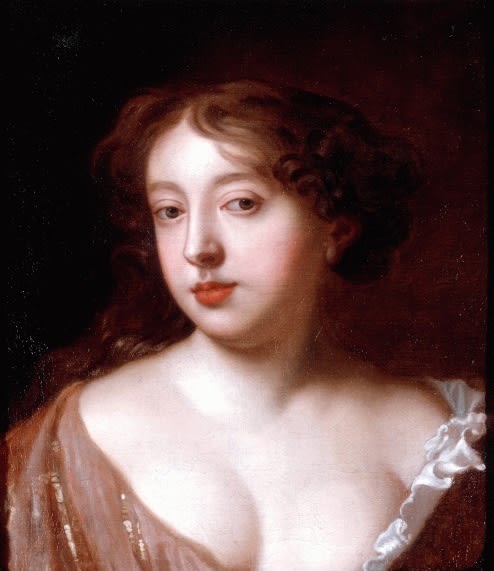
Studio of Sir Peter Lely
To view all current artworks for sale visit philipmould.com
As an actress Moll Davis enjoyed the same pedigree and path to the Royal favour as her contemporary and rival Nell Gwynn. Famously she impressed by her performance in D'Avenant's play The Rivals, and after singing the heart-rending song ''My Lodgings, it(sic) is on the cold, cold ground,'' -as contemporaries were pleased to observe- her lodgings were very soon in the royal bedchamber. Her activities are best and most assiduously noted by Samuel Pepys. He states, 7 March 1666-7, that at the Duke's playhouse (Lincoln's Inn Fields): ''little Miss Davis did dance a jigg after the end of the play, and there telling the next day's play, so that it come in by force only to please the company to see her dance in boy's clothes; and the truth is there is no comparison between Nell's [Nell Gwynn's] dancing the other day at the King's house in boy's clothes and this, this being infinitely beyond the other.''
On 5 Aug. 1667 he saw ''Love Tricks, or the School of Compliments,'' by Shirley, and chronicles that ''Miss Davis dancing in a shepherd's clothes did please us mightily.'' On 11 Jan. 1667-8 he says: ''Knipp came and sat by us. She tells me how Miss Davis is for certain going away from the Duke's house, the king being in love with her, and a house is taken for her and furnishing; and she hath a ring given her already worth 600l.'' Mrs. Pepys says, 14 Jan. 1667-8, that she is ''the most impertinent slut in the world;'' and on the same date quoted the opinion of Mrs. Pierce, that ''she is a most homely jade as ever she saw, though she dances beyond anything in the world.'' Her final departure from the stage is chronicled 31 May 1668: ''I hear that Mrs. Davis is quite gone from the Duke of York's house, and Gosnell comes in her room.'' She had danced ''her jigg'' at a performance at court a few nights previously, when the queen, it was supposed through displeasure, ''would not stay to see it.'' On 15 Feb. 1668-9 she was living in Suffolk Street and was the possessor of ''a mighty pretty fine coach. Sadly, she enjoyed little further prominence as a royal mistress after this date, and the King is said to have tired of her avarice.
The present portrait derives from a three-quarter length by Sir Peter Lely which depicts her with the unguent jar of St Mary Magdalen, placing her in the guise of the reformed sinner, as well as providing a witty conceit for the display of a very decolletage. It has not precisely been established whether this mode is employed by Lely and his contemporaries for the portrayal of mistresses alone, but references to the Magdalen occur also in a portrait of Hortense Mancini (the same composition as the present painting) and in a portrait of the lady known as Margaret Hughes (Tate Gallery). The popularity of portraits of Royal mistresses attests to the status that these women enjoyed in their heyday. The occupied a position of remarkable stardom, comparable to the great sex symbols of the twentieth century. Numerous repetitions of their portraits would be commissioned from Lely and thus produced by the artists of his studio, many of whom such as John Greenhill or Nicolas de Largilliere were to become considerable masters in their own right. Sometimes a single image might be reproduced consistently many years after the first appearance of their original. This is particularly true of Lely's paintings of the most popular mistress of them all, Barbara Villiers Duchess of Cleveland. The most eagerly-sought icons in the 1670s and 1680s were still often those based on sittings of the 1660s.
Provenance
The Dowager Lady Oppenheimer, Knightsbridge, LondonBe the first to hear about our available artworks
* denotes required fields
We will process the personal data you have supplied in accordance with our privacy policy (available on request). You can unsubscribe or change your preferences at any time by clicking the link in our emails.